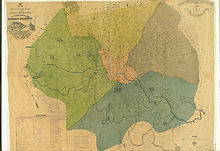Sectors of Bucharest
Romania |
|---|
 |
This article is part of a series on the politics and government of Romania |
Constitution
|
Government
|
Parliament
|
Judiciary
|
Political parties
|
Elections
|
Administrative divisions
|
Foreign relations
|
Politicians
|
|
The Municipality of Bucharest (the capital of Romania) is divided into 6 administrative units, named sectors (sectoare in Romanian), each of which has their own mayor and council, and has responsibility over local affairs, such as secondary streets, parks, schools and the cleaning services.
Each of the 6 sectors contains a number of informal districts (cartiere) which have no administrative function:
Sector 1: Dorobanți, Băneasa, Aviației, Pipera, Aviatorilor, Primăverii, Romană, Victoriei, Herăstrău, Bucureștii Noi, Dămăroaia, Străulești, Chitila, Grivița, 1 Mai, Pajura, Domenii and a small part of Giulești - the part with Giulești Stadium
Sector 2: Pantelimon, Colentina, Iancului, Tei, Floreasca, Moșilor, Obor, Vatra Luminoasă, Fundeni, Ștefan cel Mare
Sector 3: Vitan, Dudești, Titan, Centrul Civic, Balta Albă, Dristor, Lipscani, Muncii, Unirii
Sector 4: Berceni, Olteniței, Văcărești, Timpuri Noi, Tineretului
Sector 5: Rahova, Ferentari, Giurgiului, Cotroceni, 13 Septembrie, Dealul Spirii
Sector 6: Giulești, Crângași, Drumul Taberei, Militari, Grozăvești (also known as Regie), Ghencea
Contents
1 History
2 List of sectors by area
3 List of sectors by population
4 List of sectors by population density
5 Notes
6 References
History

The five culori in 1871
Initially, Bucharest was divided into plăși. In 1798, there were five of these: Târgul, Podul Mogoșoaiei, Târgul de afară, Broștenii and Gorganul. During the Russo-Turkish War (1806-1812), these were given the names of colors (Roșu - Red; Galben - Yellow; Negru - Black; Albastru - Blue and Verde - Green) and called culori ("colors"). Roșu, the smallest, composed of the commercial center and a narrow strip on the right bank of the Dâmbovița River, was disbanded at the beginning of the 20th century, its territory divided among the other four. After World War I, each of the four culori, also called sectoare by this time, was given its own mayor and council. At the beginning of Ion Antonescu's regime, the culori were briefly abolished but restored several months later.[1]
In 1950, soon after the onset of the Communist regime, the culori were abolished and replaced by eight raions, each with its own local administration: Grivița Roșie (1), 30 Decembrie (2), 1 Mai (3), 23 August (4), Tudor Vladimirescu (5), Nicolae Bălcescu (6), V.I. Lenin (7) and 16 Februarie (8). In 1968, the raions became sectors, their names replaced by cardinal numbers. In 1979, Sector VIII was merged into Sector I and Sector II into Sector 3, yielding the present six sectors.[1]
List of sectors by area

The six sectors
| Rank | Sector | Area (km²) |
|---|---|---|
| 1 | Sector 1 | 67.5 |
| 2 | Sector 6 | 38 |
| 3-4 | Sector 3 | 34 |
| 3-4 | Sector 4 | 34 |
| 5 | Sector 2 | 32 |
| 6 | Sector 5 | 30 |
List of sectors by population
| Rank | Sector | Population (October 2011) |
|---|---|---|
| 1 | Sector 3 | 385,439 |
| 2 | Sector 6 | 367,760 |
| 3 | Sector 2 | 345,370 |
| 4 | Sector 4 | 287,828 |
| 5 | Sector 5 | 271,575 |
| 6 | Sector 1 | 225,453 |
List of sectors by population density
| Rank | Sector | Population density (inh/km²) |
|---|---|---|
| 1 | Sector 3 | 11,336 |
| 2 | Sector 2 | 10,793 |
| 3 | Sector 6 | 9678 |
| 4 | Sector 5 | 9053 |
| 5 | Sector 4 | 8466 |
| 6 | Sector 1 | 3340 |
Notes
^ ab (in Romanian) "Împărțirea administrativă a Bucureștiului - scurt istoric", Agerpres, June 9, 2011
Template:Decision no. 1127/1968 for the administrative-territorial delimitation of Bucharest *) Amendments (...) Text published in M.Of. of Romania. In force since August 1, 1968
References
(in Romanian) Statistics and Demographics relating to Bucharest Sectors
Coordinates: 44°25′00″N 26°06′00″E / 44.4166°N 26.1000°E / 44.4166; 26.1000
